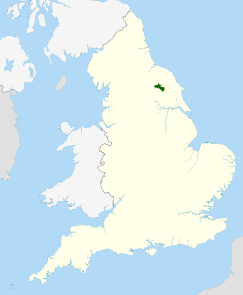Howardian Hills facts for kids
Quick facts for kids Howardian Hills |
|
|---|---|

View of the Howardian Hills
|
|

Location of the Howardian Hills AONB in the UK
|
|
| Location | North Yorkshire, England |
| Area | 79 sq mi (200 km2) |
| Established | 1987 |
The Howardian Hills are a special, beautiful area in North Yorkshire, England. They are known as an Area of Outstanding Natural Beauty (AONB). This lovely countryside sits between the Yorkshire Wolds, the North York Moors National Park, and the Vale of York. The hills get their name from the Howard family, who have owned land here for a long time.
Contents
What are the Howardian Hills like?
The Howardian Hills cover about 79 square miles. They are a mix of rolling hills and thick woodlands. This area is found between the flat farming lands of the Vales of Pickering and York.
How the Hills were Formed
The hills have bumpy ridges that reach up to 558 feet (170 meters) high. These ridges are an extension of the Hambleton Hills in the North York Moors. The ground is made of Jurassic limestone. This type of rock, along with fields, forests, and scattered trees, makes the area look very unique.
The Kirkham Gorge
On the eastern side of the hills, the River Derwent flows through a deep, winding valley called the Kirkham Gorge. This gorge was formed a long time ago. It was an overflow channel for a huge ancient lake called Lake Pickering, which was created by glaciers.
Villages and Buildings
There are no big cities within the Howardian Hills AONB. However, the market towns of Helmsley and Malton are very close by. You can find a line of villages with natural springs from Malton to Hovingham.
Most of the older buildings in the area are made from local limestone. They often have red pantile roofs. Many villages grew up around large country estates. Because of this, they have kept their traditional look. The village of Ampleforth, with its famous Abbey and College, is also located here.
How Land is Used
The land in the Howardian Hills is used for farming. There are excellent fields for growing crops, areas for grazing animals, and managed woodlands. This mix of uses makes the countryside very attractive and diverse.
Wildlife and Nature
The Howardian Hills AONB is very important for wildlife. It has many special habitats listed in the Biodiversity Action Plan (BAP). These include:
- Lowland broadleaved woodlands
- Wood pastures
- Very old, veteran trees
- Limestone and neutral grasslands
- Fen meadows (wet, grassy areas)
You can find many interesting animals here, such as:
- Brown hares
- Lapwings (a type of bird)
- Tree sparrows
- Barn owls
There are also some rare plants, like knapweed broomrape and baneberry.
Why the Howardian Hills are Special
The Howardian Hills are one of 46 Areas of Outstanding Natural Beauty (AONBs) in England, Wales, and Northern Ireland. AONBs, along with National Parks and Heritage Coasts, protect some of the most beautiful and unspoiled places in the country.
The Howardian Hills are an AONB because of these special qualities:
- Unique Land Shape: It's the only place in Northern England with Jurassic limestone that is an AONB. The Kirkham Gorge is a very important natural feature formed by ancient glaciers.
- Rich and Varied Scenery: The landscape is a mix of hills, valleys, woodlands, farms, pastures, wet fens, hedges, stone walls, and old estates.
- Beautiful Views: The different shapes of the land, varied land uses, and changing colors make it very pretty. You can see historic houses, large forests, wide views, and traditional buildings.
- Amazing History: The area has many old sites, including Iron Age earthworks, medieval castles, and monasteries. There are also grand houses and designed gardens like Castle Howard, Newburgh Priory, Hovingham Hall, Gilling Castle, and Nunnington Hall. These add to the dramatic scenery.
- Important Wildlife: The area has amazing plants and animals, especially around the River Derwent. It also has important fens and old woodlands that have been around for a very long time.
All these features make the Howardian Hills a nationally important landscape.
Protecting the Howardian Hills
The Howardian Hills are a working landscape, meaning people live and work there. Farming, forestry, and local businesses are important. The AONB partnership works to protect and improve this special place.
They do this by:
- Creating and following a plan to manage the AONB.
- Helping local communities work together.
- Giving advice and support to farmers and landowners. This helps them protect wildlife and landscape features.
- Working to improve public footpaths and access.
- Restoring old field boundaries like hedges and stone walls.
- Starting projects to restore and manage wildlife habitats.
- Protecting historic sites and buildings.
- Checking building plans to make sure new developments don't harm the landscape.
You can visit [1] for more information.


